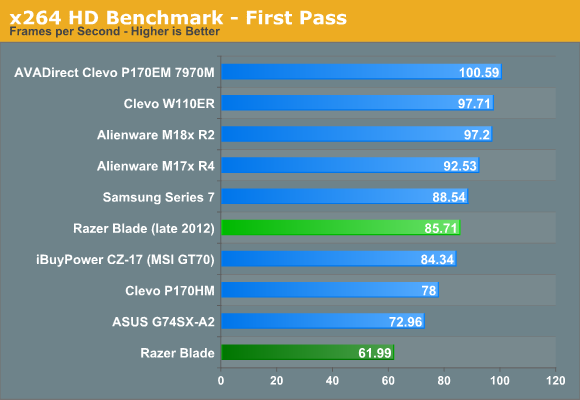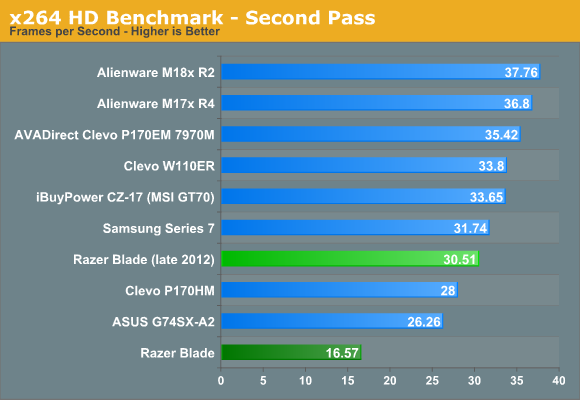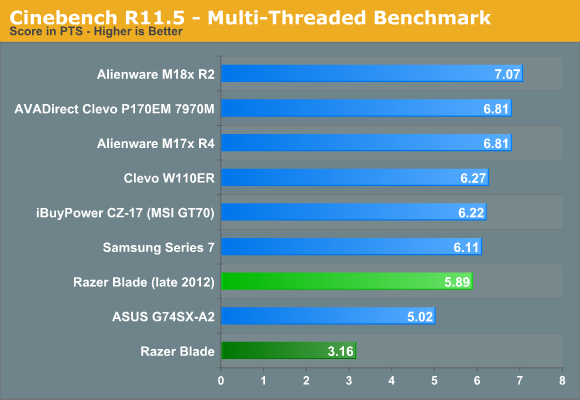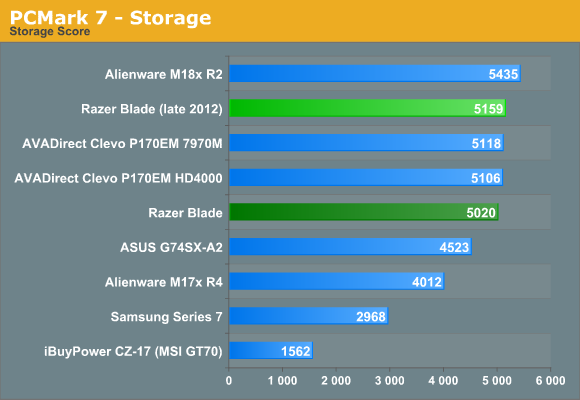The New Razer Blade: Thoroughly Reviewed
by Vivek Gowri on October 3, 2012 5:40 PM ESTRazer Blade (late 2012) - Performance
To gauge how the new Blade stacks up versus its predecessor and other gaming-class notebooks, we picked a decent selection of systems with the entire range of modern GPUs, from the GT 650M GDDR5 in Samsung's Series 7 to the pair of Alienware systems with GTX 680M and 680M SLI graphics configurations. There's a decent range of storage technologies on display here as well, with a number of different SSDs and hybrid storage solutions, along with one conventional 7200RPM hard drive.
| Notebook Configuration Overview | ||||
| CPU | Graphics | Storage | Battery | |
| Alienware M17x R4 | i7-3720QM | GTX 680M | Hybrid (Intel SRT) | 90Wh |
| Alienware M18x R2 | i7-3820QM | GTX 680M SLI | 2x SSD 830 (RAID) | 97Wh |
| ASUS G74SX-A2 | i7-2630QM | GTX 560M | Intel 320 SSD | 90Wh |
| AVADirect Clevo P170EM | i7-3720QM | HD 7970M | Crucial M4 SSD | 77Wh |
| Clevo W110ER | i7-3720QM | GT 650M | Hybrid (Momentus XT) | 62Wh |
| iBUYPOWER MSI GT70 | i7-3610QM | GTX 675M | 7200RPM HDD | 60Wh |
| Razer Blade | i7-2640M | GT 555M | Lite-On M2S SSD | 60Wh |
| Samsung Series 7 | i7-3615QM | GT 650M | Hybrid (ExpressCache) | 77Wh |
| Razer Blade (late 2012) | i7-3632QM | GTX 660M | Hybrid (DataPlex) | 60Wh |
The Blade is the first 35W quad that I’ve dealt with, and it’s the only 35W quad to go through our labs since Dell’s XPS 15 a few months ago. The Blade uses a new OEM-specific i7-3632QM that is essentially the same as the i7-3612QM in the Dell, except with 100MHz faster clocks. Performance-wise, it falls in roughly where you’d expect a 2.2GHz Ivy Bridge quad, a bit faster than the SNB quads and the 2.1GHz i7-3612QM but a bit slower than the various IVB quads that are clocked faster, starting with the 2.3GHz i7-3610 and 3615QM. I'm going to skip straight to the CPU testing this time, as I find PCMark 7 to be far too heavily skewed by other factors (SSD, Quick Sync, etc.)




There’s not too much else to say about Ivy Bridge here; it’s just a really solid CPU that’s done well for Intel. The only complaint that really can be leveled against it is that even though the tick+ update focused heavily on a new on-die graphics architecture, Intel is still playing catch up to AMD’s far more advanced integrated graphics solutions. Intel’s HD 4000 is solid enough for anything not involving gaming though, and in these applications at least, it does its job well.
Traditionally, I try to avoid all Futuremark tests, but I decided to break my rule here with the PCMark 7 storage benchmark. I wanted to see how effective NVELO’s DataPlex caching solution was with respect to Intel’s Smart Response Technology as well as the SSD in the previous Blade. The PCMark Storage score is pretty impressive, beating the SRT-enabled Dell XPS 15 (which had a 32GB cache drive) and interestingly, the old Blade as well. Admittedly, the original Blade’s SSD wasn’t the fastest in the world, even though it used the same Marvell controller as the caching SSD in the new Blade (and the Intel SSD 510, amongst other notable SSDs). We saw better Storage benchmark scores out of faster SSDs in the ASUS N56VM, which was tested using a SandForce-based drive, and Alienware M18x R2 (two Samsung SSD 830s in RAID).

It was a pretty impressive showing, and I actually wasn’t put off by the hard drive too much in day to day usage. The one place where I missed the SSD? Shut down/restart and sleep/wake cycles. I timed a cold boot at 20.8 seconds, a solid 5 seconds off the pace of the old SSDified Blade, and it was definitely something you were reminded of every time the system was rebooted or woken from sleep. As much as the new caching solutions help, nothing can touch the outright responsiveness of a real SSD.










59 Comments
View All Comments
davos555 - Thursday, October 4, 2012 - link
As one of the 10% of left handed people, I couldn't use this. I much prefer the trackpad in the middle, as I draw with my left hand (use my finger) and click with the right hand. I couldn't use it comfortably where it is on this.Old_Fogie_Late_Bloomer - Thursday, October 4, 2012 - link
And I'm a righty, but I tend to mouse lefty when I'm not gaming to even the wear and tear on my wrists. Heck, at work I use my left hand almost exclusively. That trackpad just isn't a viable solution for me. :-\adityav - Thursday, October 4, 2012 - link
Its a problem for left handers like me. I am willing to buy this but that trackpad position won't work for me.tipoo - Wednesday, October 3, 2012 - link
As we all know, that was the first and only black laptop before this.Kidding, but I don't see much similarity beside that, I don't have to repeat that the chicklet keyboard isn't unique to the MB either.
tbutler - Thursday, October 4, 2012 - link
The 'form over function' slam is really irritating. This is a *laptop.* The entire point is being able to tote it around. (If desktop space is limited, an AIO or SFF will still give you more bang for the buck than a laptop if you're not going to be carrying it around.)Therefore, size and weight are FUNCTIONAL issues. Not fashion. Size/weight vs performance is still a valid discussion, but it's a choice between two different kinds of functionality - not form over function.
By the same token, case materials are a functional issue. Logo stickers, sculpted flanges, all that crap is form - but a solid metal build vs the kind of cheap plastic described in yesterday's Clevo review will definitely affect the laptop's operation. Again, goes back to portability; a well-built case is going to hold up better under the wear and tear portable systems experience, and do a better job of protecting the internal components.
Octopilion - Friday, October 5, 2012 - link
Your argument is pointless mac book pros don't even have these specs and cost about the same price and there's a ton of sheep buying themCaptainDoug - Wednesday, October 3, 2012 - link
I just wish that there was some way to just install the OS on the Msata and then have my hard drive for anything else. I really don't get caching. I get it, but it's lame. For me, this second revision makes it a much more serious contender but I think I'd still choose the HP ENVY 17t-3200 series. You get a msata port + 2x2.5" drives. The 7850M is only slightly worse than the 660M and it has amazing sound. True it is 1.28" thick instead of .88" but it's also $1000 less and comes with a blu-ray drive. I totally understand why someone would want this though. I'm not bashing on this laptop at all, it's just not everything i want. If the Razer Blade R2 was somehow user upgradeable/configurable, that's another story. 16GB of ram, and replacable hard drives isn't too much to ask is it? That being said, if I had money to blow, I'd get this for the coolness factor over the HP Envy.JarredWalton - Wednesday, October 3, 2012 - link
I wish Razer would offer a build with a 256GB mSATA SSD with the OS and apps, and then provide a 750GB/1TB HDD for mass storage. (Or just leave the 2.5" bay open and let users add something on their own if they need more storage.) I'd also be far happier with a traditional touchpad and save the money that it costs to put the Switchblade into the laptop.VivekGowri - Wednesday, October 3, 2012 - link
If you're willing to get intimate with the DataPlex software, you can theoretically uninstall it and set up the mSATA SSD as the boot/application drive. I'm not sure why Razer didn't go that route with it, I guess it was just cheaper for them to give a smaller caching drive?s2kpacifist - Wednesday, October 3, 2012 - link
This looks like a great second entry into the gaming laptop market, but I really wish if they had a 15" flavor of the Blade, sans Switchblade. Hell, maybe even a 17" version without the switchblade touchpad. The reason? Any serious gamer will undoubtedly be using high dpi mouse for the game they are playing. The whole concept of the Switchblade is innovative, but it's probably adding some unnecessary cost and features most gamers can do without. The buttons are okay, but until Razer can get the trackpad screen to out-do what most modern smartphones can do in terms of responsiveness, browsing experience, and dpi/resolution, I think Razer can do much better without Switchblade .